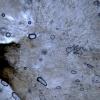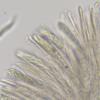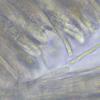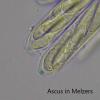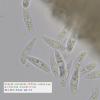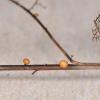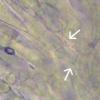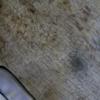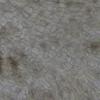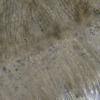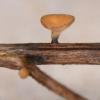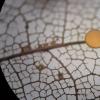
07-12-2025 16:07
Arnold BüschlenHallo, ich habe in einer Moos-Aufsammlung (epiohy

05-12-2025 17:33
 Bruno Coué
Bruno Coué
Bonjour, je serais heureux de recueillir votre avi

07-12-2025 09:24
De la pasada semana en Galicia EspañaEn el suelo

06-12-2025 00:19
 Viktorie Halasu
Viktorie Halasu
Hello, would anyone have this article, please? An

02-12-2025 18:59
This pair of ascos 2.5cm across were on recently b

02-12-2025 19:25
Buckwheat PeteHello, can anyone identify this hairy fungus growi
Hymenoscyphus ->H. vacini
Margot en Geert Vullings,
19-09-2023 10:46
With Ellis&Ellis and Fungi of Temperate Europe we ended up at Hymenoscyphus, because of the large spores.
Fruit bodies: 0.5-2mm diameter, dark yellow
Spores size: 22-23.4 x 5.6-6.06 µ (measured in water)
Ascus size: 92.7-113.5 x 9.64-11.8 µ (measured in water)
Paraphyses: VB's
Ascus: we haven't found any croziers, but we still find that very difficult.
We can't figure it out with this key: https://web.micolosa.net/wp-content/uploads/claves-hymenoscyphus.pdf
Which Hymenoscyphus could this be?
Thank you in advance,
Margot
Hans-Otto Baral,
19-09-2023 15:17

Re : Hymenoscyphus
This must be H. vacini on Acer. I never had it on another tree. Typical the skeletonized leaf and the fine dark network on the receptacle and dark stipe. The reticulum is not celar on your pics, though. And I do not know the species dark yellow or yellow-orange as I see on my screen.
I have published on this species in my paper about H. fraxineus/albidus.
The absence of croziers I cann see:
Margot en Geert Vullings,
19-09-2023 19:41
Hans-Otto Baral,
19-09-2023 20:42

Re : Hymenoscyphus
It could be, I think it is not always distinct under the micro but could be seen in macrophotos of the underside. But I really think it is not constant. More clear is the blackish stipe, like the H. albidus group.
I compared leaves of Acer pseudoplatanus with H. vacini in my folder, and actually the branching of the main veins of the leaf is alternate, contrary to the branching of the twigs of Acer.
Margot en Geert Vullings,
19-09-2023 21:38
Hans-Otto Baral,
20-09-2023 09:20

Re : Hymenoscyphus
At least the black stipe base and the dark marginal rim are typical.
Margot en Geert Vullings,
20-09-2023 10:21
Re : Hymenoscyphus
Thank you very much Zotto.
We saw that there is already one sighting in the Netherlands with the name Lanzia vacini.
Margot
Hans-Otto Baral,
20-09-2023 10:36

Re : Hymenoscyphus
Yes, that was the old school who considered all blackening of the substrate as indication for a relationship with Sclerotiniaceae. H. albidus was therefore transferred by Korf to Lambertella.

